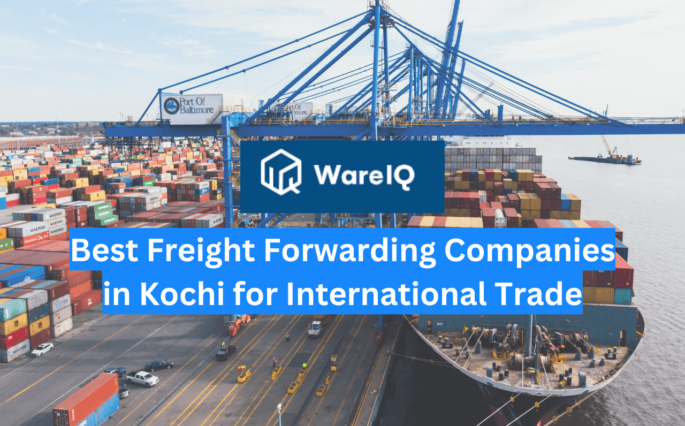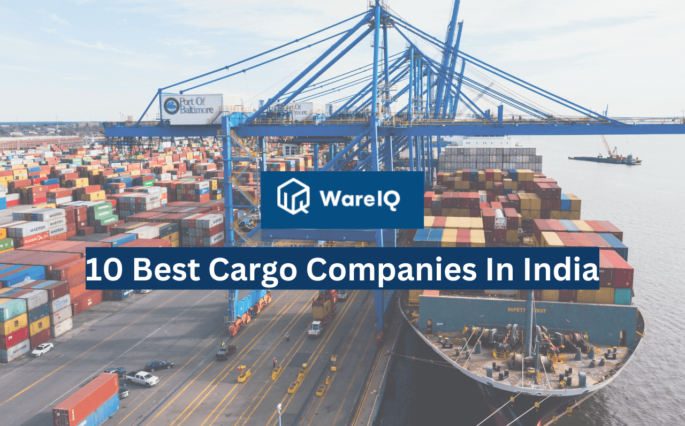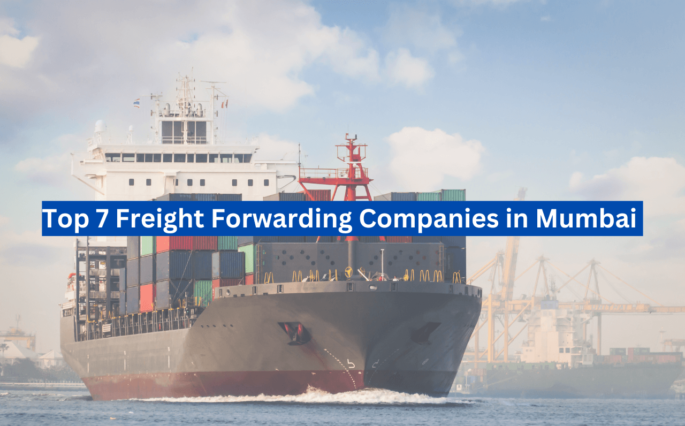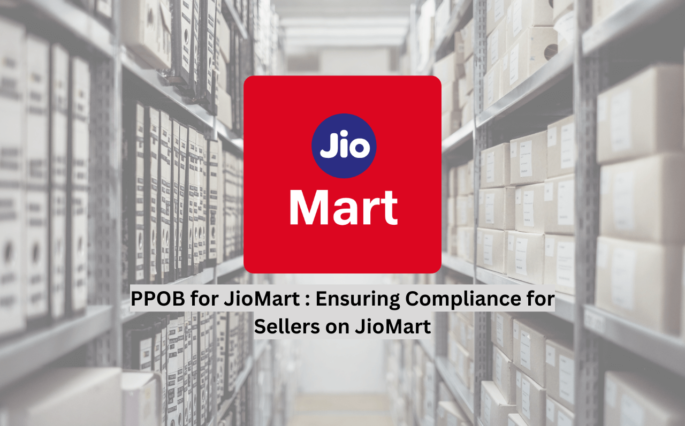Top 7 Freight Forwarding Companies in Mumbai for Seamless Trade
Freight forwarding is pivotal in the global supply chain, particularly in bustling trade hubs like Mumbai. With over 60% of India's cargo traffic passing through its ports, Mumbai is a significant player in international logistics. In fact, the city is home to approximately 1,500 registered freight forwarding companies, catering to the diverse needs of businesses looking to streamline their shipping processes and enhance operational efficiency.
As companies expand their reach into international markets, the demand for reliable logistics partners has never been greater. This article delves into Mumbai's top freight forwarding companies, exploring their unique services and strengths that enable seamless trade. Whether you are seeking specialised providers or comprehensive logistics solutions, this guide will provide valuable insights into the list of freight forwarding companies in Mumbai and freight forwarding companies in Navi Mumbai that can support your business objectives.
Top 7 Freight Forwarding Companies in Mumbai for Seamless Trade
1. Stockarea
Source - stockarea.io
Stockarea has emerged as a leading player in the freight forwarding sector in Mumbai, and it is recognised for its innovative and customized logistics solutions.
Services Offered: Stockarea provides a comprehensive range of services, including air and marine freight forwarding, customs clearance, warehousing, distribution, and domestic transportation. Their expertise in selecting appropriate vessels for different types of cargo ensures efficient transit.
Client-Centric Approach: They prioritise hassle-free transportation with streamlined cargo pickup scheduling, ensuring timely deliveries. The company's commitment to competitive pricing further enhances its appeal to businesses looking for reliable freight forwarding companies in Mumbai.
Reputation: Stockarea's focus on customer satisfaction and operational efficiency has garnered positive reviews from clients across various industries.
2. DHL Global Forwarding
Source - www.dhl.com/us-en/home/global-forwarding.html
DHL Global Forwarding is a globally recognised leader in logistics, offering extensive services tailored to meet diverse shipping needs.
Global Network: With a presence in over 220 countries, DHL facilitates seamless international trade. Their extensive network allows them to handle shipments of all sizes efficiently.
Comprehensive Services: The company specialises in customs brokerage, air freight, ocean freight, and road and rail transportation, ensuring that clients receive end-to-end logistics solutions.
Commitment to Excellence: DHL emphasises understanding client requirements and providing tailored solutions that enhance supply chain efficiency. Their reputation as one of Mumbai's top freight forwarding companies is well-deserved.
3. Maersk Line India
Soucre - www.maersk.com/local-information/imea/india
Maersk Line India has been a cornerstone of the shipping industry in India for over two decades.
Integrated Logistics Solutions: Maersk offers a wide array of services that include ocean freight, inland transportation, warehousing, and customs clearance. Their integrated approach ensures businesses can rely on a single provider for all their logistics needs.
Global Reach: With more than 130 countries, Maersk's global footprint enables them to facilitate international trade effectively.
Focus on Sustainability: Maersk is committed to sustainable practices within the logistics industry, making it a responsible choice among the list of freight forwarding companies in Mumbai.
4. Om Freight Forwarders Pvt Ltd
Source - omfreight.com
With over 40 years of experience, Om Freight Forwarders Pvt Ltd has built a solid reputation as one of Mumbai's most reliable freight forwarders.
Extensive Network: They have branches strategically located throughout India, allowing them to provide customised freight solutions tailored to client needs.
Comprehensive Offerings: Their services include customs clearance, warehousing, and distribution, executed promptly and affordably through strategic alliances with customs brokerages.
Client Relationships: Om Freight focuses on building long-term relationships with clients by delivering consistent quality service and support.
5. Falcon Freight
Source - www.thefalconfreight.com
Falcon Freight stands out for its comprehensive cargo services tailored to meet specific client requirements.
Custom Solutions: They specialise in air and sea transport logistics and are known for their reliable customs clearance processes.
Door-to-Door Services: Falcon offers efficient door-to-door shipping solutions that ensure timely delivery of goods.
Reputation for Reliability: Their commitment to customer satisfaction has made them a preferred choice among businesses looking for dependable freight forwarding companies in Navi Mumbai.
6. Jeena and Company
Source - jeena.com
Jeena and Company is transforming traditional freight forwarding services by focusing on quality and innovation.
Sector Diversity: They cater to various industries, such as retail, electronics, e-commerce, and electrical sectors.
Wide Range of Services: Jeena offers consolidation, groupage, chartering services and ample warehousing facilities tailored to specific cargo needs.
Quality Assurance: Their emphasis on high-quality service delivery ensures that clients receive superior support throughout shipping.
7. Swarex Shipping & Aviation Pvt Ltd
Source - swarex.com
Swarex specialises in container freight operations, focusing on providing cost-effective shipping solutions.
Expert Guidance: They offer practical advice on optimising shipping costs while ensuring compliance with all regulatory requirements.
Documentation Management: Swarex excels at managing documentation efficiently to facilitate smooth transportation from origin to destination.
Robust Service Model: Their commitment to reliability positions them as one of the premier choices among the freight forwarding companies in Mumbai, ensuring that client shipments are handled with care.
These seven companies exemplify excellence within the logistics sector in Mumbai. By offering tailored solutions that cater to diverse logistical needs, they play a crucial role in facilitating seamless local and international trade operations. Whether you require specialised services or comprehensive support, these firms are well-equipped to meet your business objectives.
Also check - Best Cargo Companies In India
Comparison of Top 7 Freight Forwarding Companies in Mumbai
Before diving into the detailed comparison of Mumbai's top freight forwarding companies, it's essential to understand the critical role these firms play in facilitating trade and logistics. With Mumbai being a central commercial hub, choosing a reliable freight forwarder can significantly impact a business's efficiency and success. The following table provides a comprehensive overview of Mumbai's leading freight forwarding companies, highlighting their services, global reach, unique strengths, and customer focus.
Company NameServices OfferedGlobal ReachUnique StrengthsCustomer FocusStockarea- Air & marine freight- Customs clearance- Warehousing- DistributionLocal & International- Tailored solutions for diverse cargo types- Competitive pricingSmall to medium enterprisesDHL Global Forwarding- Air freight- Ocean freight- Customs brokerage- Road & rail transport220+ countries- Extensive global network- Strong client partnership focusMultinational corporationsMaersk Line India- Ocean freight- Inland transportation- Warehousing- Customs clearance130+ countries- Integrated logistics solutions- Commitment to sustainabilityLarge-scale businessesOm Freight Forwarders Pvt Ltd- Customs clearance- Warehousing- DistributionNational- Long-standing reputation- Extensive branch networkLocal businessesFalcon Freight- Air & sea transport logistics- Customs clearancePrimarily Local- Reliable door-to-door shipping solutionsE-commerce and retail sectorsJeena and Company- Consolidation- Groupage- CharteringNational & International- Focus on quality service across diverse sectorsRetail, electronics, e-commerceSwarex Shipping & Aviation Pvt Ltd- Container freight operations- Documentation managementLocal & International- Cost-effective shipping solutions- Expert guidanceSMEs and startups
Key Takeaways:
Stockarea excels in providing customised logistics solutions tailored to the specific needs of small to medium enterprises.
DHL Global Forwarding and Maersk Line India are ideal for large-scale businesses due to their extensive global networks and comprehensive service offerings.
Om Freight Forwarders Pvt Ltd is a trusted partner for local businesses, leveraging its long-standing reputation and extensive branch network.
Falcon Freight is particularly suitable for e-commerce and retail sectors, focusing on reliable door-to-door services.
Jeena and Company stands out for its commitment to quality service across various industries.
Swarex Shipping & Aviation Pvt Ltd offers cost-effective solutions, making it an excellent choice for SMEs and startups looking to optimize their shipping processes.
Also check : List of the Best Freight Forwarding Companies in Kochi
What Shipping and Logistics Benefits Can WareIQ Offer?
WareIQ is a Y-Combinator-backed eCommerce full-stack platform offering multi-channel fulfillment across D2C, Marketplaces, Quick Commerce, and B2B (General Trade & Modern Trade)
Our solution offers:
The pan-India network of Seller Flex & FAssured is compliant across 12+ cities and is operated by WareIQ and shipping partners for last-mile delivery across 27000+ pin codes.
Multi-Channel Fulfilment Platform with plug-and-play integrations across marketplaces (Amazon, Flipkart, Myntra, Nykaa, etc.), D2C platforms (Shopify, Magento, Woocommerce, etc.), WMS, and ERPs to support fulfilment across distributors, flagship stores, and eCommerce channels with analytics capabilities to assess operational performance.
Inventory LogIQ: An AI-led multi-channel inventory planning solution to minimise stockouts and automate replenishment.
Leverage Tech-enabled returns QC solution to capture, centrally store, and auto-index HD media evidence of damaged or missing returned products and eliminate marketplace claim rejections.
A host of seller enablement and support—dedicated account manager, APOB/PPOB registrations, GST registration, NDR & COD verification, etc.
Conclusion
Selecting the right freight forwarding partner is crucial for businesses aiming to enhance their logistics efficiency and ensure seamless trade operations. The freight forwarding companies in Mumbai offer diverse services tailored to meet the unique needs of various industries. From established giants like DHL Global Forwarding and Maersk Line India to specialised providers like Stockarea and Falcon Freight, each company brings its strengths to the table. By leveraging these options, businesses can optimise their supply chains, navigate the complexities of international shipping, and ultimately drive growth in an increasingly competitive market.
Whether you are exploring the list of freight forwarding companies in Mumbai or looking for specific solutions from freight forwarding companies in Navi Mumbai, these firms are well-equipped to support your logistics needs.
You may also like to read: Best Freight Forwarding Companies in India
FAQs About Freight Forwarding Companies in Mumbai
What services do freight forwarding companies in Mumbai typically offer?Freight forwarding companies in Mumbai provide a wide range of services, including air, ocean, land transportation, customs clearance, warehousing, distribution, and cargo insurance. They work closely with businesses to develop customised solutions that meet specific shipping requirements, ensuring efficient logistics management.How do I choose the right freight forwarding company in Mumbai?When selecting a freight forwarding company in Mumbai, consider factors such as the company's experience, reputation, network of partners, and track record for timely deliveries. Additionally, assess their ability to provide personalised services tailored to your business needs, which is crucial for effective logistics management.What should I provide to ensure safe and timely delivery with a freight forwarder in Mumbai?To ensure safe and timely delivery, provide accurate details about your cargo, including dimensions, weight, and value. Collaborate with your freight forwarder to create a comprehensive shipping plan for potential challenges like customs clearance or adverse weather conditions. Additionally, consider purchasing cargo insurance for added protection.Are there specific freight forwarding companies in Navi Mumbai?Yes, several reputable freight forwarding companies in Navi Mumbai offer services similar to those in Mumbai. These companies cater to local businesses and industries while providing access to major shipping routes and logistics support.How can freight forwarding companies help optimise my supply chain?Freight forwarding companies in Mumbai are vital in optimising supply chains by managing logistics efficiently. They streamline customs clearance and transportation management processes, reduce shipping errors, and improve delivery times. By leveraging their expertise, businesses can enhance competitiveness in the global market.









